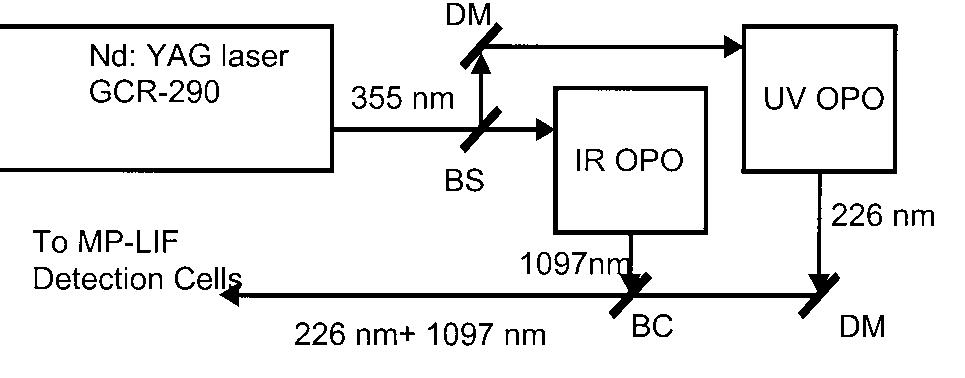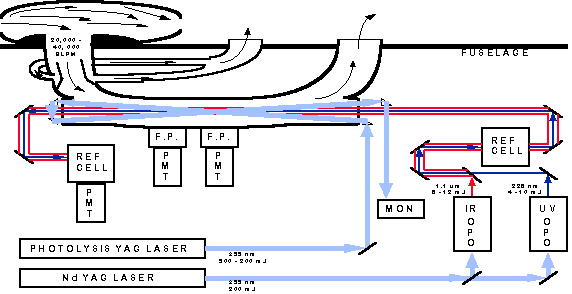|
Georgia
Institute of Technology’s Airborne Laser Induced Fluorescence
Experiment (GITALIFE) measurements of NO and NO2
The
spectroscopically selective two‑photon laser‑induced
fluorescence (TP‑LIF) technique has been used by the Georgia
Institute of Technology group to measure NO in the remote atmosphere
since 1983 (Hoell et al., 1985, Bradshaw et al., 1985,1998) and NO2
since 1986 (Sandholm et al., 1990, 1992, and 1994). In this approach,
226 nm and 1097 nm laser beams are used to sequentially excite rotationally
resolved transition in the NO molecule. The measured fluorescence
resulting from this two photon excitation occurs in a spectral region
near 190 nm which is free from laser generated background noise. The
sensor deployed on NASA's TRACE P airborne field measurement program
used two new Nd:YAG (GCR model 350) operating at 20 pps and four
Optical
Parametric Oscillators (OPOs). The
instrument layout, as depicted in Figure 1, shows the OPOs being pumped by one
Nd:YAG laser, while the second Nd:YAG produces the photolysis wavelength used
to
photo-dissociate NO2

Figure
1. Schematic for MP‑LIF excitation sources, BC, BS are
beam combining and separating dichroic mirrors (DM).
In
this configuration, an injection seeded Quanta Ray GCR Nd:YAG
laser is used as the primary pump laser source for the OPOs.
This system is capable of producing the required wavelengths
with sufficient energy while occupying less space and weighing,
~700 lbs lighter, than our PEM Tropics system. The
frequency doubled output of one of the OPOs is used to generate
typically 4 mJ/pulse levels of 226 nm energy to excite an electronic
NO transition. While
a second infrared operated OPO is then used to generate typically
2 mJ per pulse of 1097 nm energy to excite a rotational NO transition. This
system has a couple of unique design features that contribute
to its performance:
Spectroscopic
specificity from coincident excitation of two separate ro‑vibronically
resolved electronic transitions that enable dilution/calibration
techniques to be used
High
confidence in the measurements within transient (i.e., plume)
events is accomplished through the use of multiple detectors
and double coincidence signal processing techniques along with
continuous monitoring of the instrument background. The latter
eliminates possible effects from spurious noise sources such
as cosmic rays, EMI, and/or aerosol scattered UV photons.
As
in PEM‑Tropics, a 8 ns laser pulse from a Nd:YAG laser
photolyises the nitrogen dioxide molecules at 355 nm. Quantitatively
carrying out the photolytic conversion in a single laser pulse
has enabled us to greatly minimize potential interferences from
wall‑catalyzed thermal and photolytic processes. This permits
us to design a sample inlet system that capitalizes on the independence
of the TP‑LIF technique's signal strength and sensitivity
on the flow rate through the sensor. The modified sensor uses
a large volume‑to‑surface ratio sampling manifold
that is fed at high flow‑rates (>3 x 10^4 lpm) using
ram‑air (see Figure 2).

Figure
2. Schematic representation of the sensor as it was deployed
during NASA TRACE P.
This
configuration turns over the gas sample with in the manifold
faster than the laser pulse rate (i.e., sample residence time
through instrument <0.03 s whereas the pulse-to-pulse separation
is 0.05 s). This short residence time, large diameter flow system "effectively
eliminates" the possibility of interferences from wall‑catalyzed
decomposition of thermally labile nitrogen‑containing compounds
such as HO2NO2. Wall‑catalyzed
photolytic interferences are also "effectively eliminated" as
only the central portion of the flow field (1 cm^2 of the 45
cm^2 full area) is probed within 50 ms by all lasers. A
computer controlled (and adjustable) 50 ms delay is used between
the photolysis laser pulse and the TP‑LIF NO fluorescence
excitation laser pulses. This time delay enables the nascent
photo-fragmented NO population to repartition into an ambient
temperature Boltzmann distribution. In this scheme, a single
fluorescence monitoring cell is used to detect NO and NO2 on
alternate laser pulses. This configuration increases the absolute
accuracy of the NO2 measurement by eliminating the subtle differences
that can arise in previously used separate NO and NO2 sampling
cell arrangements
|